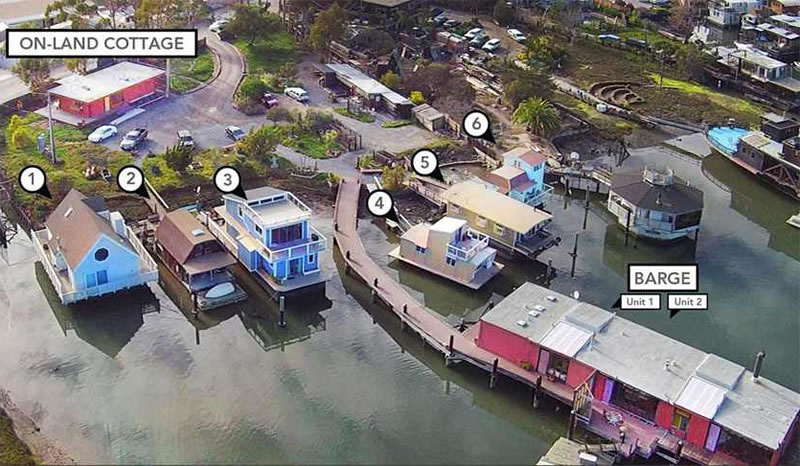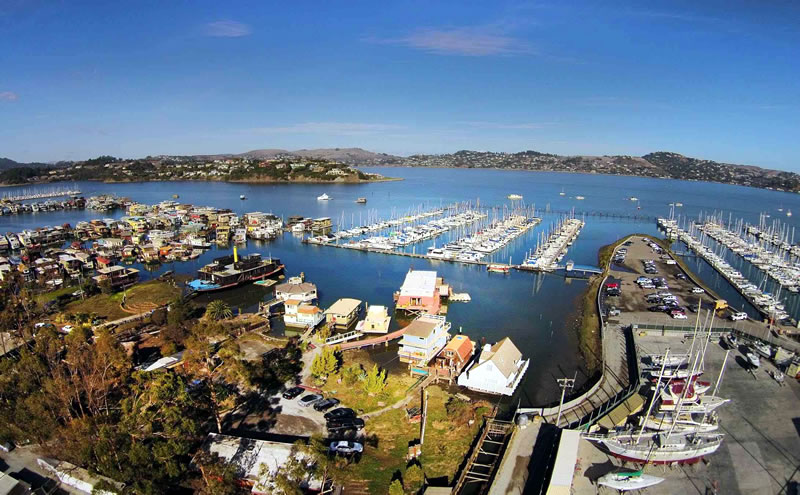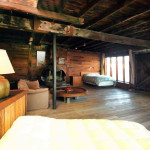BayHaven Harbor is a collection of 6 floating home slips, an on-land cottage, and a rustic two-unit residential barge. And the assemblage, which is also known as 60 Varda Landing, is now on the market for $3.8 million, with a listing touting “a rare opportunity to own an historic piece of the Sausalito waterfront while offering the unique combination of income from [the] floating home harbor and development potential.”
The current rents for the slips range from $599 to $800 per month, the cottage is rented for $2,650, unit number two on the barge is occupied by the owner, and unit number one, which includes a rather awesome wood burning fireplace, is rented for $2,000.
The floating home community in Sausalito evolved from a re-purposing of surplus maritime vessels after the WW II ship yards closed. We’ll let you decide if yet another re-purposing might be possible.




A surprising number of funky low-rent setups like this still exist in southern Marin. I think Marin is just beginning to see the intense development pressures that are reshaping the Peninsula and San Francisco.
I live in Corte Madera/Larkspur and the forces for and against development/redevelopment are just beginning to size each other up, figure out what is at stake. It is hard to strive for density and infill when the few traffic corridors to/from 101 are already maxed out during commute. Higher density development along these corridors doesn’t make sense when the density will (perhaps) never get to the point of creating the type of public transport where folks can abandon their cars.
On the other hand, the attitude of “build nothing” (the position of many since the Win Cup fiasco in Corte Madera) misses the chance to create something better. What is the vision?
Some dense development around ferry terminals and SMART stations?
Wasn’t the right place to new start infill development here right next door, where SMART would meet the ferries and GGT buses? Amazing how fast that idea got shut down.
The seller could market this property as invulnerable against sea level rise.
Marin is almost a no-growth county. The population has grown at a rate of about a thousand people per year for 40+ years, per US Census:
1970 206k
1980 223k
1990 230k
2000 247k
2010 252k
2013 258k
Slow and steady.
Why would anyone pay a slip fee for a houseboat when you can just squat in SF, like they did on Mission Bay creek?
Hey Jake
I think Marin’s population growth could be characterized as much greater than San Francisco County.
Your figures show a 25% population growth 1970-2013 in Marin County.
SF county shows about a 12.9% growth during the same period (1970-2010).
Here are the data from US census for SF County:
1950 775357
1960 740316
1970 715674
1980 678974
1990 723959
2000 776733
2010 808235
Going back to 1950, I bet Marin’s comparative growth rate would be even greater. (I am cherry-picking those numbers, of course.)
SF County’s population growth was also slow and steady 1970-2010. I don’t think it is anymore.
Marin is going have a hard time resisting continued growth in the face of what is going on around it. An even higher (than historic) population growth rate here is possible…or likely. What is Marin going to look like in 2050?
SF had mild white flight for two decades so apples to oranges really.
One more point: assuming a continued 25% growth rate over the next 40 years, Marin will add another 64,000 people by 2050. That is more people than currently live in San Rafael (Marin County’s biggest city).
The shape of the two growth curves is different. Marin had slow growth before the car and GG Bridge, except for a bump after the 1906 quake. Then rapid growth through the 1960s. But they didn’t join BART and they stopped big projects like Marincello, and basically went back to slow growth. They still haven’t solved their water problem. More than 90% of the population growth in Marin since 1970 is in San Rafael and Novato. Aside from some infill along 101, there has been almost no growth anywhere else. Fairfax, San Anselmo, and Ross have fewer people than in 1970; and Mill Valley, Corte Madera, and Sausalito have only a few percent more than in 1970. FWIW, the official CA state forecast for Marin is to grow 7% total over the next 40 years (namelink).
SF has been more boom and bust. The WWII boom leading to the 1960s and 1970s bust due to the decline of the port and PDR, and then the current boom from roughly 1980 on based on the computer and medical/financial services industries filling the port/pdr void. Salesforce Tower, the new UCSF Mission Bay campus, the Rincon Hill area NAP and datacenters, and the optical fiber under almost every street in SoMa and FiDi represent the current boom.
The historic decennial census for bay area counties back to 1860.
Population decline was due to suburban white flight without a doubt. My father’s Balboa HS reunions are on the Pennisula. There is no point in having in SF because very few stayed
White flight was part of it. According to the Census SF’s white population declined by about a third or 200k from 1960 to 1980. It has been more or less the same ever since. Also, 280 and BART were built in the 1960s and they made it easier to live outside SF and commute in for work.
Almost all the population decline was for people under the age of 18. This was when SF transitioned more to being a place to work than a place to raise children. In 1960 the population of SF under the age of 18 reached a peaked at 24.4%. it has been falling ever since and in 2013 was 13.4%. And it is not just school age kids. For every 2 children under the age of 5 in SF today, there were 3 in 1960.
There has been a big change in the job mix too. SF has lost 100,000 PDR jobs over the last 40 years, during which PDR jobs went from roughly 4 out of 10 jobs in SF to about 1 in 10. A lot of those jobs and those workers went to the east bay.
Thanks for the info, Jake. And I see what you are saying.
Isn’t it relatively recent that the Bay Area tech boom is in full effect in San Francisco – where previously it was more a Silicon Valley phenomena leading to southbound morning traffic as some preferred to live in the city away from their jobs. I think Marin has been relatively quiet when it comes to tech money, even compared to parts of the East Bay, because it is so far from the Peninsula. A few years back, we competed to buy our place in Marin, but with 1-2 other buyers, not the 10-20 we were facing in the Mission. But Marin is increasingly a good place to commute to tech jobs now in downtown San Francisco/South of Market.
Regarding the .gov predictions (great site!), it is so hard for me to believe that Marin is going to have a growth rate between Del Norte (6% projected) and Tuolumne (9%) counties, while is it geographically between Sonoma (27%) and San Francisco (29%). My neighbors who have lived here since the 1960-80s and perhaps even the 1990s certainly have the attitude of “don’t change a thing,” (including apparently opposing redevelopment of the unfortunate Lucky’s market in downtown Larkspur). I lived in the Mission for 30 years starting in 1990 – I saw how the people moving in there changed the neighborhood both with money and a new attitude toward change and development. Comparing the Mission to Marin is far-fetched, I know. But I think the next generation moving here may have attitudes more like the San Francisco newbies than the Marin old-timers.
Unless there is something in the water.
The dot-com boom was centered in SF as well. At least the way I remember it, it felt even more so then the current boom.
It was because the first boom was much more visible in your face with plenty of conspicous consumption. Nowadays, tech folks are more conservative.
I have recently noticed a lot of more cars and traffic around my usually quiet part of town. Probably a mix of lower gas prices and increased population as well. The home improvement/construction stores are still pretty busy during the whole week.
If you’re measuring the boom by number of jobs added, the center was far south of SF. Perhaps Palo Alto? CSCO and BRCM probably added more jobs than the entire city of SF.
Marin has its draw — almost everyone I knew who were professionals, white, married, and had children lived in Marin (Mill Valley, Tiburon, etc.) for the good schools, sunny weather, as well as the quiet and peaceful lifestyle. There are no graffiti, grime, or minorities. Marin County Courthouse is a Frank Lloyd Wright building. Even the physicians showed a marked sense of calm and ease when they saw patients in their Marin office compared to SF.
Then again I am not sure why there is a higher breast cancer rate for the female populace in Marin or why Marin moms refuse to vaccine their kids. Thoughts or theories?
SF Planning put together a brief summary of the dot com boom and early bust in SF (8 page pdf at namelink) as part of the eastern neighborhood planning. It covers job growth, vc investment levels, map of the new livework buildings, commercial and residential rental costs, and has plenty of stats and graphics. It is the most succinct summary of this period for this place that I know. Here’s a snippet:
“Between 1994 and 2000, San Francisco experienced a period of sustained growth and added over 86,000 jobs.
…
In 1996, venture capital (VC) companies provided about $10 billion to Internet and other high-tech start-up companies in San Francisco. Funding continued at about that level until 1998, when the funding rose 20 percent to $12 billion, even though many of the companies were not generating any profit. The amount of venture capital funding continued to rise and many new high-tech companies started to grow very rapidly, hiring staff and leasing more office space. In 1999, VC funding rose to $40 billion. In 2000, the last year for which we have complete information, VC funding exceeded $50 billion for start-up companies in San Francisco. This funding allowed the expansion of the high-tech office space. The reported leasing activity increased from about 0.5 million square feet to 4.25 million square feet.”
Whenever anyone tells you the Giants $300 million stadium construction and $200 million payroll transformed SoMa and/or Southbeach, just remember well over $100 billion in VC money washed through in 5 years.